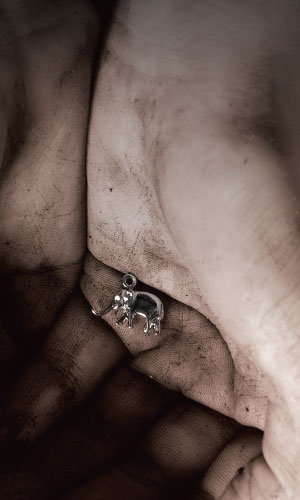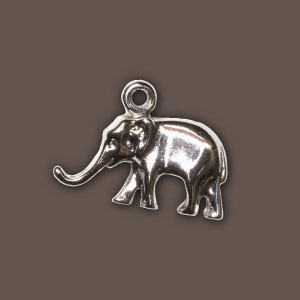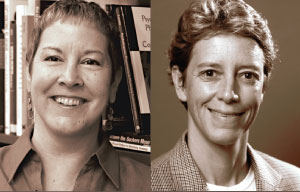Feature
the Gift of Humanity
Marketing professor expands her research in consumer behavior to show how, even in the most extreme circumstances, giving and receiving gifts is part of what makes us human.
Very often, the youngest to arrive at Auschwitz-Birkenau never passed the first selection for gas chambers on the transport platform.
On a cold January morning in 1943, prisoner Rena Kornreich was standing in the front row enduring another agonizingly long roll call before being sent off to a day’s hard labor. So she had a clear view of the column of new arrivals—all children, hundreds of children (the Nazis had emptied a Jewish orphanage, other prisoners surmised)—as the SS guards marched them from the train through the camp and straight to the gas chambers.
Having arrived at Auschwitz on the first transport of Jewish women, Rena had grown accustomed to the horrors of the concentration camp. Still, the sight of so many young children being lead to their deaths stirred a rage inside of her—but like all the others who watched it happen, she stood silent, unable to stop it.
Days later, when a friend from their hometown of Tylicz, Poland, asked what was wrong, Rena told her about the children. A few days after that, the friend, whose job was sorting the belongings of incoming prisoners for shipment to Germany, met Rena in the latrine and slipped something small into her palm: a silver elephant charm.
“The charm looked as if it belonged to a child, and I thought of you,” her friend said.
“Elephants are supposed to be good luck. I don’t want it to go to the Germans.” Rena embraced her friend and slipped the trinket into the hem of her skirt.
In her 1995 memoir, Rena’s Promise, Rena Kornreich Gelissen recounted the incident and what her friend’s gift meant to her: “The silver elephant is a reminder of the children I watched walk to their deaths. It is the only mark of their passing—a tiny gravestone in my hand. I place it under my tongue during selection so it can be spit into the dirt if I go to the gas or if I’m beaten to death. My commitment to this small child’s charm is that it should never get into Nazi hands, that even if I do not survive, it shall.”
Tina Lowrey had only a general knowledge of the Holocaust. Although she saw Schindler’s List in the theaters after it was released in 1993, she never was assigned to read Anne Frank’s diary for any class in school. But Lowrey, a professor of marketing at UTSA, had always been interested in learning more about the subject. So when a colleague in the field of consumer behavior approached her about teaming up to write an analysis of giftgiving among prisoners in the Nazi concentration camps, she jumped at the chance.
In their research, Lowrey, an expert on the subject of gift-giving, and Jill Klein, of Melbourne Business School in Australia, found that prisoners did indeed give gifts to each other in the concentration camps. The pair described the findings in a 10,000-word paper, “Giving and Receiving Humanity: Gift-Giving Behavior in Extreme Settings.” In it, they theorize that, if the sharing of gifts and marking of birthdays and other milestones occurred in a setting as extreme as Auschwitz, then the act of gift-giving must be an intrinsic part of expressing one’s humanity.
Supporting their arguments are anecdotes culled from more than two dozen books penned by former concentration camp prisoners of Polish, Czech, Hungarian, Romanian, Italian and French origin. The stories include mentions of tangible gifts fraught with meaning, such as the elephant charm Rena Kornreich Gelissen received in acknowledgement of her sadness, as well as intangible gifts meant to help a fellow prisoner get through another day, such as making their bunk or propping them up during a long roll call. They include selfless gestures and more calculated ones—such as giving something to a Capo (fellow prisoners who worked as administrators in the camps) in hopes of a better work assignment, or to a cook, in hopes of getting a more generous ladle of soup at mealtime.
Most frequently, inmates gave gifts of food and clothing— things that are given in normal settings, Lowrey noted. In the concentration camps, however, these gifts had an entirely different meaning.
“It’s not buying someone’s favorite chocolates for their birthday; it’s smuggling out a smashed raspberry that someone was fortunate enough to find,” she said. “It’s not trying to find a sweater in the right color; it’s putting on three pairs of socks and smuggling them out so that your bunkmates have a new pair of socks.”
A personal pursuit
“Lowrey never intended to pursue the subject of gift-giving as a research interest. But in 1990, as a graduate student at the University of Illinois at Urbana–Champaign, she volunteered to help collect data for a study of consumers’ gift-buying habits. The project was so successful that researchers extended it over a decade. That project helped establish Lowrey as an expert in gift-giving and ritual behavior.
In 1999, a year before wrapping up that project, Lowrey co-chaired the European conference of the Association for Consumer Research. That’s where she met experimental social psychologist Jill Klein, who was at the conference to present her findings on the effectiveness of corporate responses to boycotts. At that time, Klein was on the faculty at the Fontainebleau campus of international graduate business school INSEAD.
But it was about a personal project that Klein approached Lowrey. Klein, an American-born Jew whose father survived the Holocaust, asked if Lowrey would want to collaborate on a paper that focused exclusively on gift-giving in concentration camps. The paper could have implications for other types of extreme settings and for people with limited means. Klein’s assertion was a compelling one.
“We’ve been missing a big part of the gift-giving literature,” she said, “because we focus on people who have resources.”
Klein’s father, Gene Klein, was still a teenager when his family was sent from Czechoslovakia to be interred in a series of concentration camps, including Auschwitz. In order to gain more insight and perspective on the stories her father shared with her, Klein started reading Holocaust memoirs on her own. Her professional interests as a business school professor were piqued when she noticed that all of the memoirs contained mentions of trading goods; in Auschwitz, there was a veritable black market that existed in the camp latrines, with a slice of bread as the basic unit of currency.
“The general thing that struck me was people who were very hungry were trading [food] for possessions that made them feel human,” Klein said. For instance, she cites one female memoirist who traded her bread ration for a needle and thread to fashion a headscarf from a ragged cloth to cover her shaved head—not to stay warm but perhaps as a reminder of normalcy.
From her readings, Klein gathered data for a paper on trading in the concentration camps (which eventually was published in the Journal of Macromarketing in 2008). But she noticed something else from her reading. While many prisoners did engage in trading, the memoirs contained other instances of sharing that essentially amounted to gift-giving: the sharing of food, the proffering of an extra pair of wool socks to help another prisoner stay warm, and, in one extreme case, the act of taking the place of an ailing prisoner in the selection line to spare him certain death.
Extreme giving
When she began collaborating with Klein, Lowrey started by reading every Holocaust memoir Klein had read. She treated it as work, sitting in her office and using paper clips to mark the pages of the library books, noting every instance that could possibly be construed as gift-giving. When she was done working for the day, she’d leave the memoirs behind in her office. Still, she wasn’t immune to the heart-rending stories.
The first time the colleagues were scheduled to present their research at a conference, at the Association for Consumer Research in 2006, Klein could not attend. Lowrey didn’t think anything of having to go it alone, having presented at numerous conferences before. But this one was different.
“When you’re presenting qualitative research, your data are your verbatims—your actual quotes. I could present the theory fine,” Lowrey said. “It was when I actually read the verbatims that I had some emotional difficulty.”
When she got to the verbatims—the stories taken straight from the memoirs that she and Klein were citing in their paper—Lowrey, a tenured professor with numerous publications and presentations to her credit, began to choke up. She paused in her reading and looked out at her audience, and saw before her a roomful of colleagues and supporters who were wiping their own tears and nodding back at her to give her encouragement.
“I didn’t lose it,” Lowrey recalled. “It just wasn’t my normal, everyday conference presentation.”
The stories—almost all of which begin with a transport in an overcrowded cattle car to a concentration camp and often end with a death march across Europe as the Nazis retreated from the advancing Allied armies—are difficult to read. Because survival was always on the forefront of the prisoners’ minds, one would expect that every circumstance in those extreme settings would have pushed them toward protecting their own self-interests, Lowrey and Klein said. Yet instead, the researchers found exactly the opposite.
“Every force in the camp should have led people to extreme selfishness and animal-like behavior,” said Klein. “And people were sometimes selfish and they were sometimes animal-like, as the memoirists themselves say. But what we see a lot more prevalently is a lot of helpfulness and a lot of heroic, heroic behavior.”
In their paper, the authors quote one memoirist, Dutch-born Louis de Wijze, who makes the every-man-for-himself assertion in his 1997 book, Only My Life: “Everyone lives for himself. Our one and all-encompassing credo is: Survive! Between the outer limits of life and death, previous values and norms lose their meaning, and our spiritual baggage gradually erodes. The only norm that counts is ‘I’. All our senses, thoughts, and deeds are used only for our own benefit.”
But, Lowrey noted, de Wijze contradicted himself less than 20 pages later in his story. He recounts passing his second selection for the gas chamber at Monowitz, only to step back in line to take the place of an emaciated Czech prisoner, at risk of not only failing to pass the selection again but of being punished if his deceit had been caught: “[The Czech prisoner’s] face reads utter despair, and his eyes are almost popping out of their sockets. He is looking straight at me,” de Wijze wrote. “Then it happens, almost involuntarily. Like a zombie, I walk toward him, hand him my bundle of clothes, and unobtrusively push him out of the line.”
“That really piqued my interest,” Lowrey said. “Here’s the memoirist himself saying [life in the camps] was nothing but selfishness—and then contradicting himself and not even realizing it.”
The de Wijze example of being prepared to give one’s life to save another is atypical of the gift-giving they most often found in the memoirs, Lowrey said, but it helped the researchers form the thesis for their paper. If the concentration camp prisoners did only what was necessary for survival, Lowrey and Klein believe, then the many instances of gift-giving they found in their readings indicate that giving is essential.
“We’re saying that giving survived, so what remains in an extreme setting like the concentration camps is clearly an indicator of something that is essential for existence and essential for expressing one’s humanity,” said Lowrey. “That’s our argument, that gift-giving clearly is essential to feeling human, expressing humanity and surviving through an extreme setting.”
Who we are as humans
For faculty such as Klein and Lowrey, the culmination of research is usually publication in a reputable academic journal. It’s an effort that requires patience. Klein and Lowrey have been at work on their concentration camp paper for several years, and “it’s still not done,” Lowrey said.
Currently, they are revising the paper to resubmit to the Journal for Consumer Research, which last year passed on their first draft. They are committed to getting their research published in the top-tier journal because, they said, this research tells a story of who we are as humans.
“This really is important behavior. It doesn’t seem that important in a middle-class setting where people with money can afford to spend $200 on each other’s Christmas present,” Lowrey said. “This [the concentration camp] is an outrageously extreme setting, but it speaks to poverty and constrained circumstances of any kind—Hurricane Katrina, a tsunami, earthquakes. These are not the same kinds of extreme settings, but they are extreme.
“But my guess is the gift-giving continues to happen, and it’s because we have to do it.”
Her co-author agreed.
“A key point of our paper is that giving a gift is a fundamental human tendency. It makes us feel human, and it makes the recipient feel human,” Klein said. “And when we have very little choice in our life, but we have just enough wiggle room to help somebody else out, we’ll do it. People will do it. Not all the time, but people will do it.”
—Rebecca Luther



